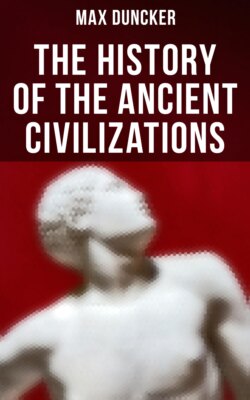Читать книгу The History of the Ancient Civilizations - Duncker Max - Страница 30
На сайте Литреса книга снята с продажи.
FOOTNOTES:
Оглавление[428] Herod. 3, 7; 1, 131; 7, 69, 86.
[429] Eratosthenes in Strabo, p. 767.
[430] Strabo, p. 777.
[431] Diod. 2, 48; 3, 44.
[432] Diod. 2, 48, 50, 54; 3, 42, 43. The accounts of the grove are taken from Agatharchides.—Strabo, p. 777.
[433] "Hist. Nat." 6, 32.
[434] Amm. Marcell. 14, 4.
[435] Herod. 3, 107–113.
[436] Heracl. Cuman. Fragm. 4. ed. Müller.
[437] Apud Strabon. p. 768 ff.
[438] Agatharch. "De Mari Erythr.;" apud Diod. 3, 45–48, and the excerpt of Photius in Müller, "Geogr. Gr. Min." 1, 111 ff.; cf. Strabo, p. 778.
[439] Strabo, p. 778.
[440] "Hist. Nat." 12, 32; 6, 32 seq.
[441] The queen of Sheba, who brings such large gifts of gold and spices to Solomon, must in any case be regarded as the queen of the rich spice land, and with this account agree other passages in which Sheba is mentioned. To the Seba, who are mentioned in Psalm lxxii. 10, 15, as rich in gold along with the Sheba, and are described in Isaiah as people of great stature (xlv. 15; cf. xliii. 3), and are placed in Genesis x. 7 among the children of Cush, I cannot assign any place. Prideaux assumes that the two nations became amalgamated; "Trans. Bibl. Arch." 2, 2.
[442] Isaiah xxi. 13, 14, 17.
[443] Dümichen, "Die Flotte einer ægyptischen Königin."
[444] G. Smith, "Assyr. Discov." p. 286; Schrader, "Keilschriften und Alt. Test." s. 56, 143, 163.
[445] G. Smith, "Assurbanipal," pp. 264, 265, 275.
[446] Gen. xxv. 1–11; xxvi. 34; xxxvi. 11.
[447] Birch, "The Annals of Tutmes III.;" "Archæolog." vol. xlv.
[448] Papyrus Harris in Chabas, "Recherches sur la Dynastie 19," p. 59.
[449] Movers, "Phœnizier," 2, 3, 302.
[450] Strabo, p. 756; Pliny, "Hist. Nat." 12, 32.
[451] Isaiah xxi. 13, 14.
[452] Movers, "Phœnizier," 2, 3, 293.
[453] Isaiah lx. 6.
[454] Herod. 3, 97.
[455] 1 Kings xxii. 49; 2, xiv. 7, 22; 2 Chronicles xvii.; 2, xxvi. 6, 7. Under Ahaz, the grandson of Uzziah, Elath was again lost.—2 Kings xvi. 6.
[456] Caussin de Percival, "Histoire des Arabes," 1, 16, 17; Wellsted, "Reisen in Arabien, von E. Rödiger," 1, 307.
[457] Prideaux, "Trans. Bibl. Arch." 2, 19.
[458] D. H. Müller, "Zeit. d. d. M. Gesellschaft," 1876, s. 522 ff.
[459] Osiander in the "Zeit. d. d. M. Gesellschaft," 10, 17–73; Praetorius, loc. cit. 26, 417 ff; Gildemeister and Levy, loc. cit. 24, 188.
[460] Genesis xxv. 1–6.
[461] Genesis xxxvi. 12–16.
[462] The table in Genesis x. 7, places Ramah, Shebah, Dedan, Havilah, among the sons of Cush, but in the genealogy of the Arabs (c. xxv.) Shebah and Dedan are given to Joktan and Midian.
[463] Nöldeke. "Ueber die Amalekiter," s. 23 ff.
[464] Caussin, "Histoire des Arabes," 1, 49, arrives at the year 794 for the birth of J'arab, by allotting thirty-three years to each generation. Wüstenfeld, in his genealogical tables, gives from thirty to thirty-four generations between Kachtan and Mohammed, and thus, though he allows forty years for each generation, cannot reach beyond the year 700 B.C. for Kachtan.
[465] Osiander, in "Zeitschr. d. d. Morgen. Gesellschaft," 10, 27.
[466] Caussin, "Histoire des Arabes," 1, 49–60; Prideaux, "Trans. Bibl. Arch." 2, 10.
[467] Caussin, "Hist. des Arabes," 1, 166 ff. Wüstenfeld ("Genealogische Tabellen") reaches higher, because, as already remarked, he allows forty years for a generation.
[468] Krehl, "Religion der Araber," s. 41, 30; Lenormant, "Lett. Assyr." 2, 10.
[469] Osiander, "Zeitschr. d. d. M. G." 7, 474; 10, 63; 11, 472; Lenormant, loc. cit. 279; Caussin, loc. cit. 1, 113; Prideaux, "Trans. Bibl. Arch." 2, 18.
[470] Krehl, "Religion der Araber," 8, 24; Osiander, "Zeitschr. d. d. M. G." 7, 473 ff.
[471] Osiander, loc. cit. 7, 487. On a stone image we find a cow and a calf with the inscription "Uzza."
[472] Krehl, "Religion der Araber," s. 73, 78. On the seven black stones of the planets at Erech.—"W. A. J." 2, 50. On the stones of the Kaabah, Lenormant, "Lettres Assyr." 2, 120 ff.; Caussin, "Hist. des Arabes," 1, 165, 176 ff.
[473] Strabo, p. 784; Suid. Θεὸς Ἄρης; Steph. Byz. Δουσαρή.
[474] Krehl, loc. cit. s. 49. See ibid. on the worship of Alful, Sahd, and Sahid.
[475] Lepsius, "Briefe," s. 330 ff.
[476] Nöldeke, "Inschrift. des Mesa," s. 6. The amalgamation of Astarte with Camus, like the amalgamation with Melkarth among the Phenicians presupposes the separate worship of the goddess.—G. Smith, "Assurbanipal," p. 283.
